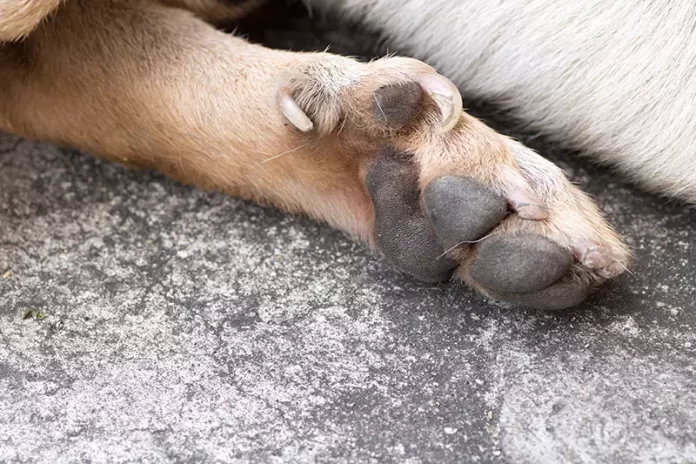Last Updated on September 6, 2023 by Fumipets
What Are Dewclaws and Why Do Dogs Have Them?
Dewclaws are small, often non-functional, extra toes found on the inner side of a dog’s leg, higher up from their other toes. These structures have evolutionary origins and serve various purposes in different breeds.
Here’s a summary of what dewclaws are and answers to common questions about them:
Key Points about Dewclaws in Dogs:
-
Evolutionary Relic: Dewclaws are thought to be remnants of digits that were once functional in a dog’s evolutionary ancestors but have become less so over time.
-
Location: Dewclaws are typically found on a dog’s front legs but may also appear on their rear legs, although this is less common.
-
Variability: Not all dogs have dewclaws, and their size and attachment can vary between breeds and individual dogs.
-
Function: Dewclaws may serve a purpose in gripping objects, stabilizing the wrist joint, or providing extra traction during certain activities, such as climbing or turning quickly.
-
Importance: While dewclaws are often considered vestigial and non-essential, they can be prone to injury, which may require medical attention.
Dewclaws in Dogs
What you know about your dog’s nails is that they sometimes leave stains on the sofa and clickety-clack on the flooring. But did you know that canines have a dewclaw, which is a kind of “extra” toenail? Continue reading to find out why canines have them and how to take care of these unique fingers to keep them healthy.
What Are Dewclaws?
Look at the front feet of your canine. The toe and tip on your dog’s dewclaw are a little higher up than the other digits. It resembles how the human thumb rests on the hand. Dewclaws are nails that some canines have on their back paws. Some varieties, such as the Great Pyrenees, have double dewclaws, which means the dewclaw area will have two fingers (each with two nails).
Why Do Dogs Have Dewclaws?
Modern dogs’ progenitors were actually climbers like cats. They were able to scale mountains and branches thanks to their dewclaws. The dewclaws, however, migrated higher up the leg and rose off the earth as the species developed. This increased dogs’ ability to run away from attackers and rendered the dewclaw useless for the overwhelming majority of canines.
Some very energetic, working varieties still use their dewclaws for balance and grasping. For hunting, military, and search-and-rescue canines, as an illustration. The dewclaws might make contact with the earth while they’re racing over unlevel ground, which would speed up their movement. Additionally, dogs from cold regions (like Alaska and Antarctica) can clamber out of the ocean by using their dewclaws to grasp ice.

Which Dog Breeds Have Dewclaws?
All canine types have front dewclaws at birth. Only a small number of varieties, including the Saint Bernard and Icelandic sheepdog, also have them on their hind feet. Your dog most likely doesn’t have dewclaws because the owner had them removed soon after delivery.
Is Dog Dewclaw Removal Necessary or Safe?
The declaws of some pups are traditionally removed a few days after delivery by some canine trainers. In order to maintain breed standards and stop further dewclaw accidents, this was done.
Dewclaw injuries do not happen very frequently in domestic dogs, though; instead, working canines who sprint through difficult territory more frequently suffer from them. Typically, pups don’t need to have their dewclaws removed for medicinal reasons. In reality, dewclaws are useful because they can increase grip on some surfaces and help to support the carpal (wrist) joint when a canine applies weight to its front feet.
Because the bones have not completely formed and the dewclaw can be simply cut off by a doctor, dewclaw removal in pups is comparatively straightforward. Despite the fact that this is needless and unpleasant for the baby, it happens swiftly and recovers well. Adult dewclaw removal necessitates a medical excision done while sedated. The veterinarian has to meticulously separate bone, nerve, muscle, and blood arteries, which is why. Additionally, recovery takes longer because canines need to wear e-collars and must limit their activity.
Common Dewclaw Injuries
Dewclaw damage is more common in dogs than toe damage. Dewclaws frequently become excessive, which is why. Back dewclaws can also occasionally be loosely connected and hang. Due to this, dewclaws are more likely to shatter as your dog draws away and become tangled in objects.
Broken Dewclaws
If the quick—tissue in the middle of the nail that contains a blood vessel—is revealed, broken dewclaws hemorrhage. If you cut the tip too short, this may also occur. Cornstarch is what Marks advises using to halt the hemorrhaging. Because it is a rudimentary hemostatic substance, the hemorrhaging will momentarily cease. If you take your canine out and about, it’s a good idea to have some on hand at home and in the vehicle. Consult a doctor if your dog’s nail is broken or the hemorrhaging doesn’t stop.
Infection
Dewclaws on your dog’s leg are susceptible to ingrown nails and nail-bed diseases just like the other digits. In addition to trauma, canines who scratch their feet frequently, such as those with sensitivities or nervousness, are another cause of dewclaw illness. A change in hue, puffiness, and stench are all indications of illness. Antibiotics, bandaging, and frequently an e-collar are used in the treatment of diseased dewclaws to prevent your dog from scratching the affected area.
Dewclaw Care
Dewclaws should be cared for in the same manner as your dog’s other nails to avoid accidents. Marks claims that you ought to watch and shape them more frequently. Dewclaws, however, are typically not an issue with proper care. The rest of the nails get worn down by going for walks on cement and playing at the park, but the dewclaw never touches the ground so it quickly becomes overgrown.
Common Questions about Dewclaws in Dogs:
Do all dog breeds have dewclaws?
No, not all dog breeds have dewclaws. Some breeds, particularly those bred for specific tasks like hunting or herding, are more likely to have them.
Can dewclaws be removed?
Dewclaw removal is a common practice, especially in certain breeds. It’s typically done when a dog is a puppy, often for safety or aesthetic reasons.
Are dewclaws prone to injury?
Yes, dewclaws can be susceptible to injuries like tearing or snagging. Keeping them trimmed and monitoring their condition can help prevent injuries.
Do dewclaws have a specific function in modern dogs?
The function of dewclaws in modern dogs is not well-defined, and they are generally considered less functional than the primary toes.
Is it necessary to trim dewclaws?
Dewclaws should be trimmed regularly, especially if they are not naturally worn down during exercise, to prevent overgrowth, which can lead to injury or discomfort.
https://www.youtube.com/watch?v=kCoz9exrYl0


















